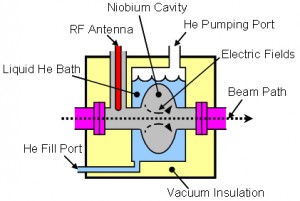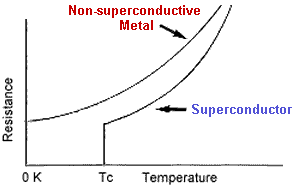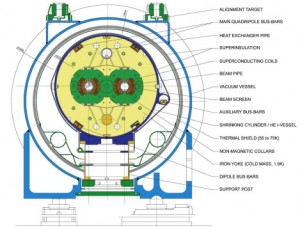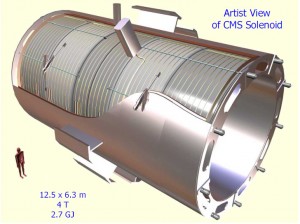This year is the 100th anniversary of the discovery of superconductivity, a state in some materials to conduct electricity without energy loss at very low temperatures. Heike Kamerlingh Onnes demonstrated the phenomenon of superconductivity in 1911 at the University of Leiden in the Netherlands when he observed the resistivity of mercury go to zero as he cooled it below 4 kelvin. Onnes won the Nobel Prize in physics for this remarkable discovery, which has had profound impacts on both science and society over the past century. Superconductivity is the central enabling technology employed in modern particle accelerators.
One of the most basic formulas we learn in physics is Ohm’s Law, V = IR. The voltage drop across a material (e.g., a wire in an electrical circuit) is proportional to the current applied and the resistance of the material. The voltage drop is zero if the resistance is zero, which is a special state for some materials at very low temperatures called superconductivity.
Onnes’s research was aimed at understanding how materials behaved as they approached absolute zero temperature. The main question was whether the resistance would go to zero at absolute zero temperature. Resistance was known to be due to the scattering of electrons by ions in the metal, so the question was whether the scattering amplitude decreased to yield zero resistance or whether the mobility of electrons also decreased, giving zero conductivity at zero temperature, which was Lord Kelvin’s hypothesis. In that case, the resistance would reduce to some value, then become infinite at zero temperature.
Onnes first developed liquid hydrogen in 1906, which enabled laboratory studies at 14 kelvin. Although the linear reduction of resistance was observed, the picture was confused by indications of flattening, which might have indicated Kelvin was correct. But the purity of the metal also affected the resistance. Then in 1908, Onnes became the first to develop liquid helium at 4.2 K; it is still the coolant of choice for modern accelerator magnets, magnetic resonance imaging and other applications. In 1911, using liquid helium, he performed the experiments that demonstrated superconductivity and was awarded the Nobel Prize two years later.
Although we almost take it for granted, superconducting magnets are the main enabling technology for modern particle colliders, bending the particle around the ring. The size of the ring is set by the bending strength, with positively charged particles accelerating in one direction and negatively charged particles sent in the opposite direction. Finally they are brought together to collide at discrete points along the ring. Superconducting magnets generate high fields and use less power than conventional magnets. The LHC has 1,232 superconducting 14.2-metre long dipole magnets with design fields of up to 8.4 tesla distributed around a 27-kilometre circumference ring. The enormous cryogenic system that is required to cool the ring delivers a total refrigeration of 150 kilowatts at 4.5 K and 20 kW at 1.9 K. The experiments also employ gigantic superconducting magnets that create a volume of magnetic field that is filled with sophisticated particle detectors.
Particle accelerators and detectors have greatly benefited from the development of superconducting technologies for our applications. We also help drive superconducting technology development and, as a result, have effectively doubled the operating gradients of superconducting magnets over the past couple of decades. For the ILC, our superconducting RF cavity design is based on one-metre nine-cell niobium cavities developed at the DESY. Niobium cavities are limited to gradients of less than 40 to 50 megavolts per metre, and for mass-produced cavities we have set a standard of 35 MV/m, with operational gradient in the machine of 31.5 MV/m. This is again about twice the operating gradient that could be achieved in real applications a decade ago.






Recent Comments